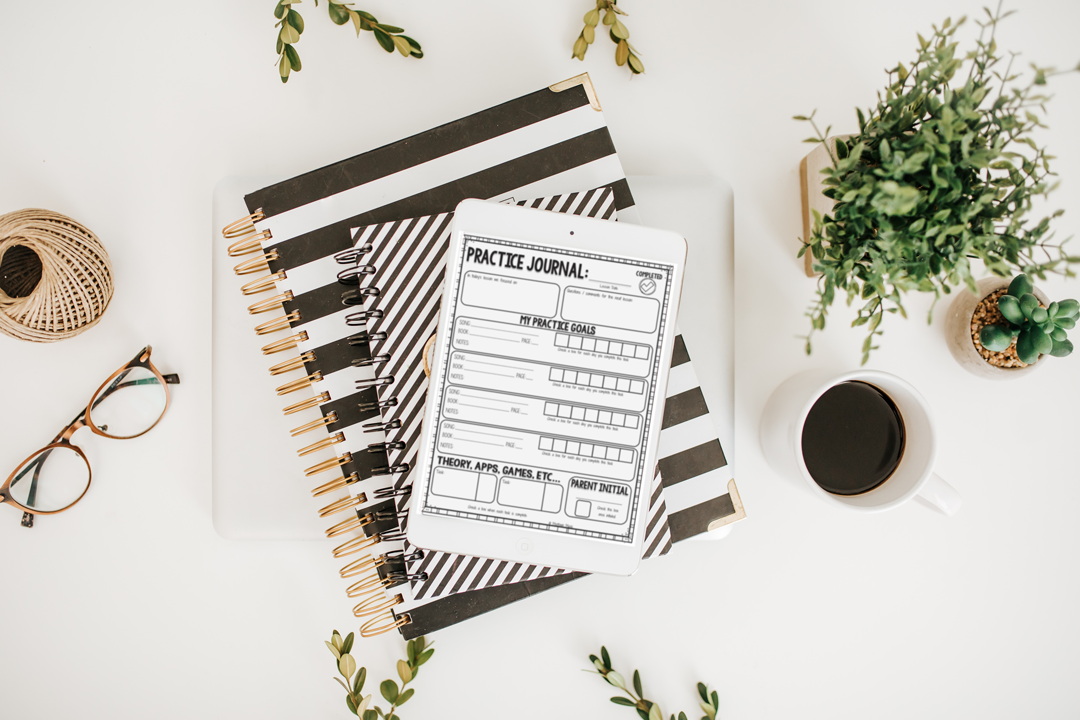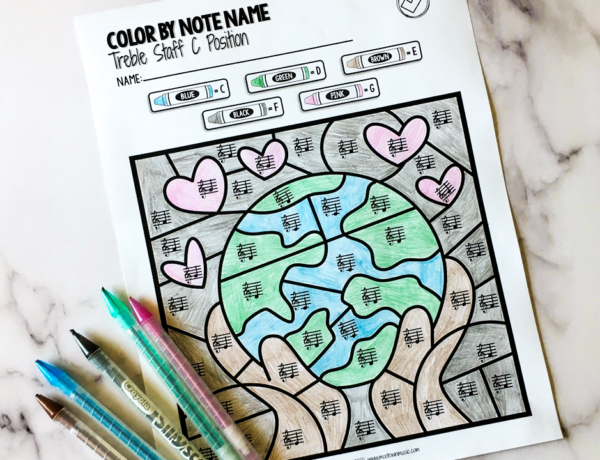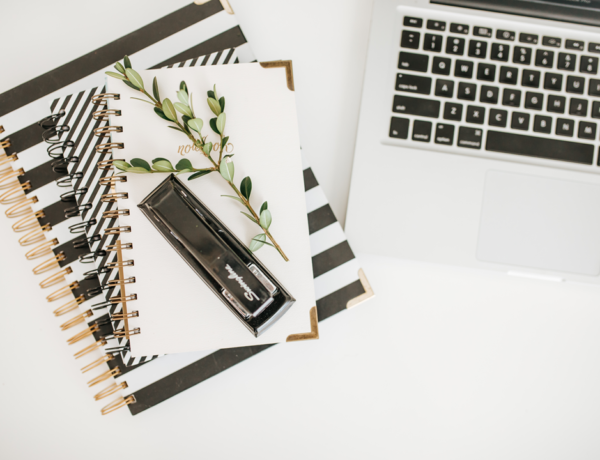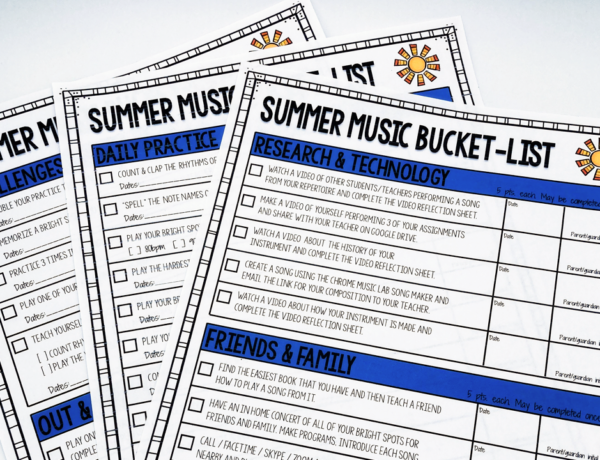Practice cards, records, journals, logs, charts – whatever you choose to call them – are an invaluable tool when it comes to a student’s musical progress. Over the course of my teaching career, the method I use to track assignments with students has evolved from a single date written at the top of a method book page, to lined notebook paper, to the detailed assignment sheets I use today. What did I learn along the way to cause me to refine my approach? The more specific, and interactive, the assignment, to more likely my students are to complete it; and, in turn, the more likely they are to make swift progress.
As I’ve made the transition to online teaching, due to social distancing regulations in my area, one of the things I’ve struggled with the most is recapturing the magic of my trusty, pen and paper, practice journals.
Through lots of trial and error (and YouTube tutorials, lol) I’ve managed to create digital replacements for my normal practice journals that have been working wonders with my students and their parents, too! Keep reading to find out how I use these practice journals with my online music students, and to grab some free samples that you can use with your students too!
Focused Practice is Key.
As we all know, focused practice is key. Ideally, we want our students to practice material which is relevant to what was covered in their lesson, rather than aimlessly playing the same song over and over. Once they head out of the lesson room door though, it’s not up to us anymore. We can hope that a parent will help carefully manage our student’s practice but, in most cases, this isn’t realistic. We can hope that our students remember their lesson word for word and stick to only the tricky parts of their repertoire that need work, but students who can practice that way are rare. So, what’s a music teacher to do?
The realities of life outside of the practice room are why it’s so important to spend time actually teaching our students how to practice, then setting them up with specific goals and concrete strategies of how to achieve them.
Scaffolding good practice habits
Of course, if you present an elementary aged student with a notebook page filled with text, that notebook is most likely going to be ignored. However, if you curate a practice document that has the expectation of interaction – writing, marking, or coloring – suddenly, students are accountable for their practice habits each step of the way. This accountability makes it more difficult for a student to fib or exaggerate their practice efforts and gets students to start thinking about the effect of their practice efforts on musical outcomes
Scaffolding looks different for each stage of development.
5, 6, 7, and 8-year-olds
For my younger students, this usually involves coloring in a picture for each day that they complete a specific assignment that I have written for them in their practice journal.
In my Teachers Pay Teachers shop, I have seasonally themed practice journals that I use with my students throughout the year. These are my go-to for my 5, 6, 7, and 8-year-old students (some younger and older students enjoy them as well). I would print out a batch of a specific design at the beginning of the week and be ready to go.
However, these didn’t translate well to online learning. With all the additional work already expected by their children’s teachers at school, parents were burnt-out. Most were annoyed by having to print out a journal each week and then photograph / scan their child’s progress to email back. As a brief solution, I made a mock document in Google Sheets. Some of my young students were able to get some use from these but, for most, the technology was too tricky to manage without direct parental supervision. This was a good Band-Aid, but I needed something better.
So, I dove into the Forms function of Adobe acrobat and created an interactive document that I can fill out digitally during an online lesson.
When we wrap up our lesson, I shoot an email to my student’s parent with the document attached. Young students can then “check” off the boxes that they would normally color with a single click or tap. To follow my student’s progress, I have asked that the digital practice journal be emailed back just prior to the start of their next lesson so I can use the screen share function to review it with the students.
Get a sample copy of a digital practice journal to use with your 6-8 year-old students
Click here!
9, 10, 11 and 12-Year-Olds
I find that as my students enter late childhood or the “tween” phase, they can take more responsibility for their practice. I start to back off on setting goals for my students and then assigning strategies for achieving them. Rather, at this stage, I start to open up the discussion for their input with leading questions like:
- What do you want to achieve this year?
- What is a small step that we could take this week to work toward your big goal?
- What strategy do you think you could use to complete this small step?
- Would you like any suggestions?
We start by setting a big goal – for the month, the semester, or the year. In almost all cases, this big goal is something that can’t be achieved by “cramming” between two lessons. Of course, the scope of the goal will depend on each individual student. Examples could be things like:
- Memorize a set of X number of pop songs
- Prepare for and complete leveled exam
- Finish a method book
- Prepare for an audition
Sometimes, the overwhelm of setting such a large goal can be helped by presenting a student with a menu of options to choose from. This is especially helpful for students who are transitioning from the “little kid” to “big kid” practice journaling.
With the big goal in mind, we break down each assignment into smaller, achievable, goals that can be completed before the next lesson. Things like:
- Play the first verse of a pop song by memory without stopping
- Play a section of an exam piece at a specific metronome setting
- Be ready to pass off the next 3 exercises in the method book
- Slowly play through the first technical requirement for an audition with no mistakes.
In addition to checking off each day of practice on their practice journals, older students are also asked to provide a “personal rating” reflection for the week. Out of 5 stars, I ask my students to evaluate the overall effectiveness of their weekly practice. Were their goals achieved? Did they spread practice out over several days, rather than cramming? Did they use the strategies discussed? I gently remind my students that these are the sort of factors which go into their personal rating when we discuss it each week. In the beginning, I like to provide frequent reminders that the goal of the personal rating is honest reflection. It’s better to have a lower rating that’s honest and accurate than a 5-star rating that doesn’t reflect what really happened.
When students first start using these practice journals, I still fill in each of the sections for them as we talk through goals and strategies. However, once they’re comfortable, we’ll start the transition to having students write down their own assignments in the provided spaces. This sets the students up to, eventually (around high school age) keep an effective practice journal in a plain notebook that they maintain themselves.
As with the little kid’s version, I took the template of my printed practice journal for tweens and turned it into an editable .pdf file which can be emailed between parent, student, and teacher. I will use the screen share feature if I am the one filling out the journal page for my students, or I will ask them to do the same on their end if they’re filling in the assignments themselves. The older kids are more independent with technology than their younger counterparts. Many have their own email addresses to access their online schoolwork. At this age, I still like to check in with parents regarding their children’s assignments. To do this digitally, I will either CC parents on the emails between the student or ask the student to do the same if they’re completing the document. Parents who aren’t present during lessons have really appreciated the extra communication during these hectic times and, of course, this provides an extra level of accountability for students.
Get a sample copy of a digital practice journal to use with your 9-12 year-old students
Click Here!
Have you changed your approach to keeping track of assignments during social distancing or online teaching? Let me know down in the comments below!






No Comments